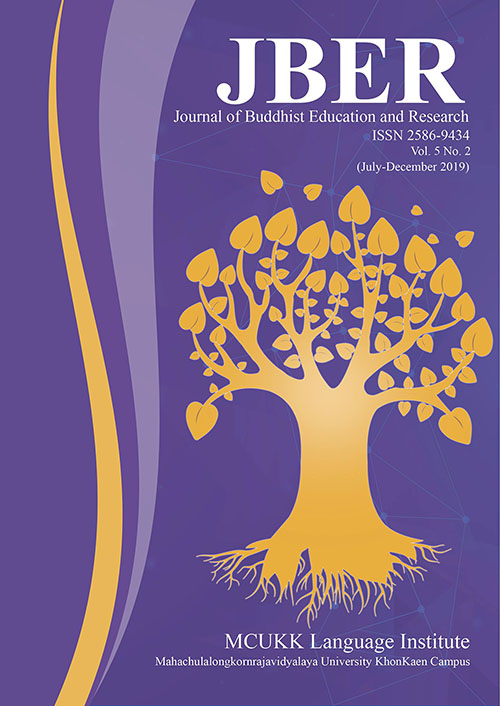การปรับตัวของสถาบันการเงินไทยเพื่อเป็นธนาคารดิจิทัล
คำสำคัญ:
ธนาคารดิจิทัล, ยุคการเงิน 4.0, การปรับตัวของสถาบันการเงินไทยบทคัดย่อ
บทความนี้มีวัตถุประสงค์เพื่อศึกษาผลกระทบของการเปลี่ยนแปลงเป็นธนาคารดิจิทัลที่มีต่อสถาบันการเงิน พนักงาน และลูกค้า และศึกษาแนวทางในการปรับตัวเพื่อรองรับการเป็นธนาคารดิจิทัลของสถาบันการเงินไทย โดยใช้ระเบียบวิธีวิจัยแบบปรากฏการณ์วิทยา โดยทำการเก็บรวบรวมข้อมูลด้วยการศึกษาจากเอกสารร่วมกับการสัมภาษณ์ผู้จัดการสาขา พนักงาน และลูกค้าของธนาคาร 7 แห่ง ในเขตอำเภอเมืองขอนแก่น จังหวัดขอนแก่น จำนวน 21 คน และวิเคราะห์ข้อมูลโดยใช้เทคนิคตรวจสอบสามเส้า
ผลการศึกษา พบว่า
1) ผลกระทบของการเปลี่ยนแปลงเป็นธนาคารดิจิทัล พบว่า ในปัจจุบันธนาคารมีการปรับตัวนำเทคโนโลยีดิจิทัลมาให้บริการด้านการเงินการธนาคารให้กับลูกค้า ด้วยการพัฒนาแอปพลิเคชั่นทางการเงินให้ทันสมัย มีความสะดวกรวดเร็วและใช้บริการได้ตลอด 24 ชั่วโมง การประยุกต์ใช้แอปพลิเคชั่นส่งผลให้ลูกค้ามีการปรับพฤติกรรมใช้บริการที่สาขาลดลง นอกจากนั้น ธนาคารส่วนใหญ่ยังมีนโยบายการปรับลดสาขา อย่างไรก็ตามพนักงานยังมีความจำเป็นในการให้บริการแก่ลูกค้า ได้เสนอให้มีการปรับบทบาทพนักงานให้เป็นที่ปรึกษาทางการเงิน โดยให้ความสำคัญกับการให้บริการด้านสินเชื่อ และการลงทุน 2) แนวทางในการปรับตัวของสถาบันการเงินไทยภายใต้กระแสการเปลี่ยนแปลงเป็นธนาคารดิจิทัล จึงมุ่งเน้นการพัฒนาศักยภาพของพนักงานให้มีความรู้และความเชี่ยวชาญให้การเป็นที่ปรึกษาทางการเงินและการลงทุน การมีแอปพลิเคชั่นทางการเงินที่ให้บริการได้หลากหลายและตอบสนองได้ตรงความต้องการของลูกค้า เพื่อให้ปรับตัวได้ก้าวทันการเปลี่ยนแปลงของกระแสดิจิทัลซึ่งภาครัฐมีบทบาทที่สำคัญในการพัฒนาโครงสร้างพื้นฐานการชำระเงินเพื่อขับเคลื่อนให้เกิดการเปลี่ยนแปลงสู่สังคมไร้เงินสดอย่างแท้จริง
เอกสารอ้างอิง
ตลับลักขณ์ ธนดิษฐ์สุวรรณ. (2560). รู้และเข้าใจ...บริบทใหม่ระบบสถาบันการเงินยุค 4.0. ค้นเมื่อ 21 ธันวาคม 2561, จาก https://www.krungsri.com/bank/getmedia/367d598f-7779-48eb-95b0-41e0bebd4974/THIP_07_Banking40_TH.aspx
ทิพย์พาพร มหาสินไพศาล. (2561). การเรียนรู้ยุคเทคโนโลยีเปลี่ยนโลกเมื่อโลกถูกจัดเก็บโดยเทคโนโลยีบล็อคเชน. วารสารปัญญาภิวัฒน์, 10(1), i.
ธนาคารแห่งประเทศไทย. (2562ก). FI_CB_041_S3 รายได้ค่าใช้จ่ายของธนาคารพาณิชย์จดทะเบียนในประเทศ. ค้นเมื่อ 10 มกราคม 2563 จาก http://www2.bot.or.th/statistics/BOTWEBSTAT.aspx?reportID=674&language=TH
_______. (2562ข). FI_CB_060_S2 สรุปจำนวนรวมสาขาของธนาคารพาณิชย์ทั้งระบบ. ค้นเมื่อ 10 มกราคม 2563 จาก http://www2.bot.or.th/statistics/ReportPage.aspx?reportID=802
_______. (2562ค). PS_PT_009 ธุรกรรมการชำระเงินผ่านบริการ Mobile banking และ Internet banking 1. ค้นเมื่อ 10 มกราคม 2563 จาก http://www2.bot.or.th/statistics/ReportPage.aspx?reportID=688&language=th
นฤมล จิตรเอื้อ. (2561). พฤติกรรมการใช้บริการธุรกรรมทางการเงินผ่านระบบพร้อมเพย์ในเขตกรุงเทพมหานคร. วารสารวิชาการ มหาวิทยาลัยศิลปากรสาขามนุษยศาสตร์ สังคมศาสตร์ และศิลปะ, 12(2), 774-803.
พรชัย ชุนหจินดา. (2560). ฟินเทค (FinTech) เพื่อก้าวสู่การเป็นประเทศไทย 4.0 [ฉบับอิเล็กทรอนิกส์]. วารสารอิเล็กทรอนิกส์การเรียนรู้ทางไกลเชิงนวัตกรรม, 7(1), 1-23.
พิมพ์ธัญญา ฆ้องเสนาะ. (2560). “มาตรฐานคิวอาร์โค้ด” มิติใหม่ระบบการชำระเงินไทย หนึ่งก้าวที่ใกล้ของสังคมไทยไร้เงินสด. ค้นเมื่อ 13 ธันวาคม 2561 จาก https://www.parliament.go.th/ewtadmin/ewt/parliament_parcy/download/article/article_20171215114509.pdf
สฤณี อาชวานันทกุล. (2559). รู้จักบล็อกเชน (Blockchain) เทคโนโลยีปฏิวัติสังคม. ค้นเมื่อ 7 มีนาคม 2562 จาก https://thaipublica.org/2016/07/blockchain-revolution/
Montazemi, A.R. & Qahri-Saremi, H. (2015). Factors Affecting Adoption of Online Banking: A Meta-Analytic Structural Equation Modeling Study. Behavior Research Methods, 46, 29-40.





